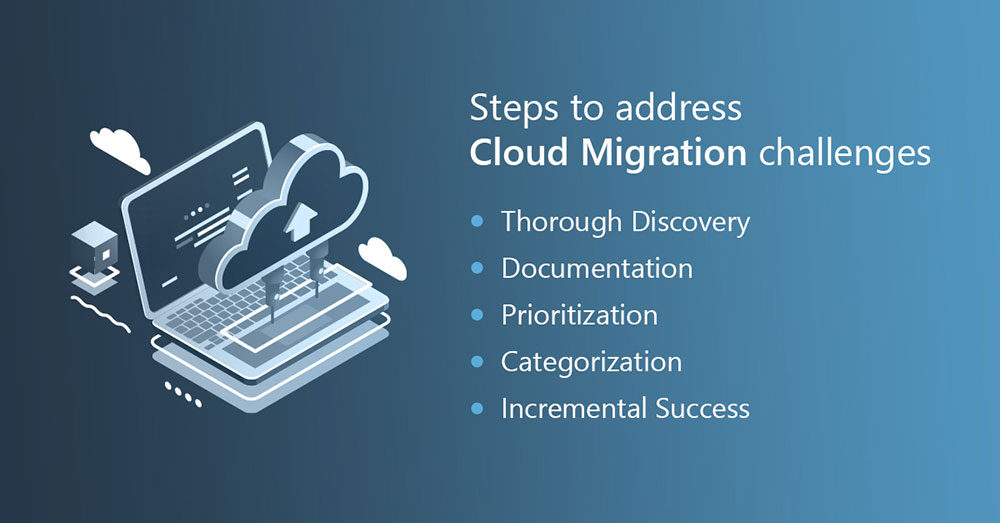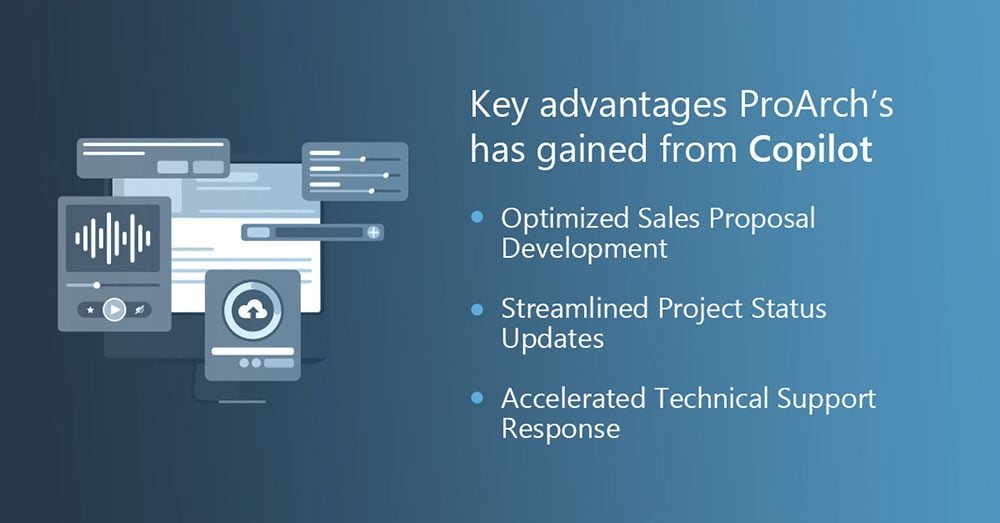Q&A with ProArch’s Cloud Expert: Cloud Migrations, Security, and Where to Focus Next

When businesses started migrating to the cloud, they often cited the move from capital expenditure to operational expenditure or high availability of systems. But how can companies harness the clouds’ full potential to drive real, tangible results?
In this exclusive Q&A, Jeanne Morelli, Managing Director of Cloud & Infrastructure pulls back the curtain on how ProArch is revolutionizing cloud-based infrastructure to meet the ever-changing demands of modern businesses.
From productivity to next-level customer experiences, Jeanne reveals the game-changing strategies that are helping ProArch’s clients stay ahead of the curve. She also covers how cutting-edge tools like Copilot for Microsoft 365 are being wielded to optimize cloud infrastructure and unlock new realms of possibility.
How does ProArch’s cloud infrastructure support internal and client needs?
“ProArch is entirely in the cloud. We no longer have any servers on-premises. This allows us to provide the services that our clients and our people need quickly,” says Morelli. As Jeanne explains, “The cloud has allowed ProArch to expand our workforce quickly, anywhere across the globe.” ProArch relies heavily on Azure Virtual Desktop (AVD) to quickly onboard new resources wherever they are. “Our teams must react to our customers’ requirements using the right tools and platforms. AVD allows us to securely provide this flexibility without costly delays.”
Microsoft Intune is another core component of ProArch’s IT management strategy. As Jeanne notes, “With Microsoft Intune, we can configure baseline images for our groups of users, providing the right apps to the right people.” Internal IT relies on Microsoft Intune to make sure the infrastructure stays updated with the latest versions of software including any end of support deadlines that are coming up. “The roll out of Windows 11 has been swift with very little interruption to the end user.” On top of the management benefits, the architecture and strategies behind ProArch’s cloud-first environment that closely aligns to Microsoft best practices has “reduced our security risk drastically.”
What are the key security advantages of cloud adoption?
“Organizations have to spend a significant portion of the IT budget on security due to the state of our world,” Jeanne says. She sees that organizations are not taking advantage of all the security and compliance capabilities in the Microsoft 365 suite they’re paying for.
Jeanne highlights several key areas where organizations can leverage the cloud to enhance their IT operations:
Security and Policy Management: Jeanne emphasizes the importance of setting baselines for your organization so that you know how devices are configured, what security policies are implemented, and you’re confident that updates are occurring regularly.
Continuous Monitoring and Vulnerability Management: This continuous monitoring capability is crucial in today’s rapidly evolving threat landscape. “There are tools within the Microsoft 365 tool set that help to not only secure the organization, but also provide ongoing monitoring,” Morelli states.
Device Management and Governance: To maintain a strong security posture, organizations should take full advantage of cloud-based tools. She stresses the importance of ongoing device management and governance. “The automation of provisioning and secure access has so significantly changed our ability to focus on other projects that can have a greater impact on the business.’
Risk Reduction: “So many threats are coming into our organizations all the time,” Morelli warns. She emphasizes the critical balance between maintaining business operations and reducing organizational risk.
Compliance Management: Cloud-based compliance tools can help organizations navigate these complex requirements more effectively. Jeanne notes that, “A lot of those M365 compliance tools can help manage that for them,” pointing to the value of cloud-based compliance management tools.
What are the primary challenges that organizations face during cloud migrations?
The greatest challenge of moving to the cloud is what you don’t know. Most organizations don’t know what they have or what applications they use or who has access to it. It’s the wild west.
Jeanne stresses the importance of discovery and planning. She explains, “Go through an in-depth discovery process to determine what should be archived, what security should be in place, and who and how it should be accessed.”
Jeanne recommends a structured approach to address these challenges:
- Conduct a comprehensive assessment of the existing IT environment.
- Create and maintain detailed documentation of the infrastructure and applications.
- Begin with easily migrated systems to build confidence and familiarity with the cloud and the management tools.
- Group migration tasks, based on complexity and business criticality.
- Start with achievable goals before tackling complex migrations.

Jeanne’s blunt advice for organizations considering cloud migration, “If you don’t know what you have, it’s going to take some time and planning to make it happen.”
Be prepared for the fact that if you haven’t maintained a really stringent structure of your infrastructure or you haven’t maintained that inventory, it’s not always a swift move into the cloud. You have to be willing to tackle the hard stuff.
Where are businesses focusing their cloud investments?
“In one way or another, much of the investments in cloud are focused on accessibility, resiliency, security, management and governance.”
Other key areas Jeanne sees organizations focusing in:
- Modernizing applications and infrastructure: Companies are “finally moving the last of the apps to modern apps or migrating the servers they reside on to the cloud,” completing their transition to cloud-based systems. They are completing their plans toward cost control.
- Cloud-native identity management: There’s a shift towards “managing identity through cloud-native tools like Entra,” enhancing security and streamlining access control.
- Automated management and governance: Organizations are adopting “modern, automated management and governance through tools like Intune” to improve efficiency and maintain compliance.
- Cloud and virtual desktops: Companies are investing in “cloud or virtual desktops to better control the experience for end users,” ensuring consistent and secure work environments.
- AI and Data Governance: There’s a growing focus on “governance of data so that AI can be used confidently and securely within the organization,” preparing for the integration of AI technologies.
How is ProArch using Copilot for Microsoft 365?
On top of working with customers on their own use of Copilot for Microsoft 365, ProArch has adopted it internally as well. “We have been rolling out Copilot for Microsoft 365 to different groups one at a time. For each, we determine the tasks that are done every day that Copilot can help with.”

ProArch has implemented a “Center of Excellence” to identify and leverage Copilot, leading to significant improvements in several key areas:
- Proposal Development: Copilot assists in quickly generating elements for sales proposals based on meeting transcripts and internal documentation. Jeanne explains, “We can now use Copilot with a custom prompt to bring the resources together into communication, proposals, etc. It has saved so much time.”
- Project Management: “Our project management team has status updates with customers and instead of writing, rewriting, and editing notes, everything is captured in the transcript and then Copilot creates a recap.”
- Customer Support: The delivery teams have seen remarkable improvements. Jeanne says, “Since the start of this financial year, we have had successive months of perfect scores on our delivery by our support teams.” She attributes this success to Copilot’s ability to quickly retrieve relevant information from extensive documentation. “They can ask Copilot a question and be very specific about the information they’re looking for and which customer and they can get the answer back on how to resolve that issue.”
“AI makes us think differently. We get to be creative.”
As we look to the future, it’s evident that the integration of AI and other advanced technologies into cloud infrastructure management will only grow in importance. Organizations that proactively adapt their cloud strategies to incorporate these tools stand to gain significant advantages in agility, scalability, and performance.
ProArch’s journey serves as an example of how cloud infrastructure can be optimized to meet and exceed business potential. Wherever you are in your cloud journey, ProArch can help.

Assistant Manager Content Parijat helps shape ProArch’s brand voice, turning complex tech concepts into clear, engaging content. Whether it’s blogs, email campaigns, or social media, she focuses on making ProArch’s messaging accessible and impactful. With experience in Oracle, Cloud, and Salesforce, she blends creativity with technical know-how to connect with the right audience. Beyond writing, she ensures consistency in how ProArch tells its story—helping the brand stay strong, authentic, and aligned with its vision.


